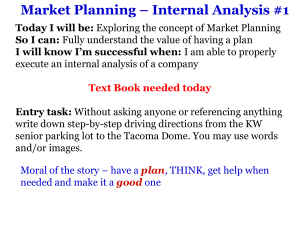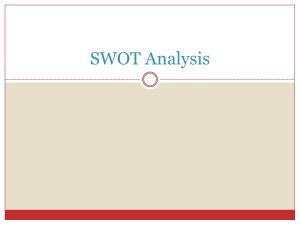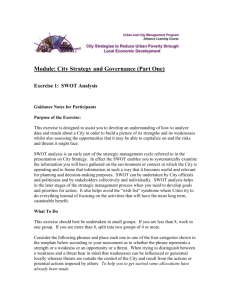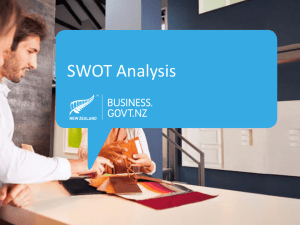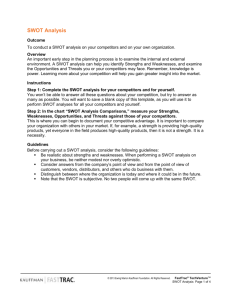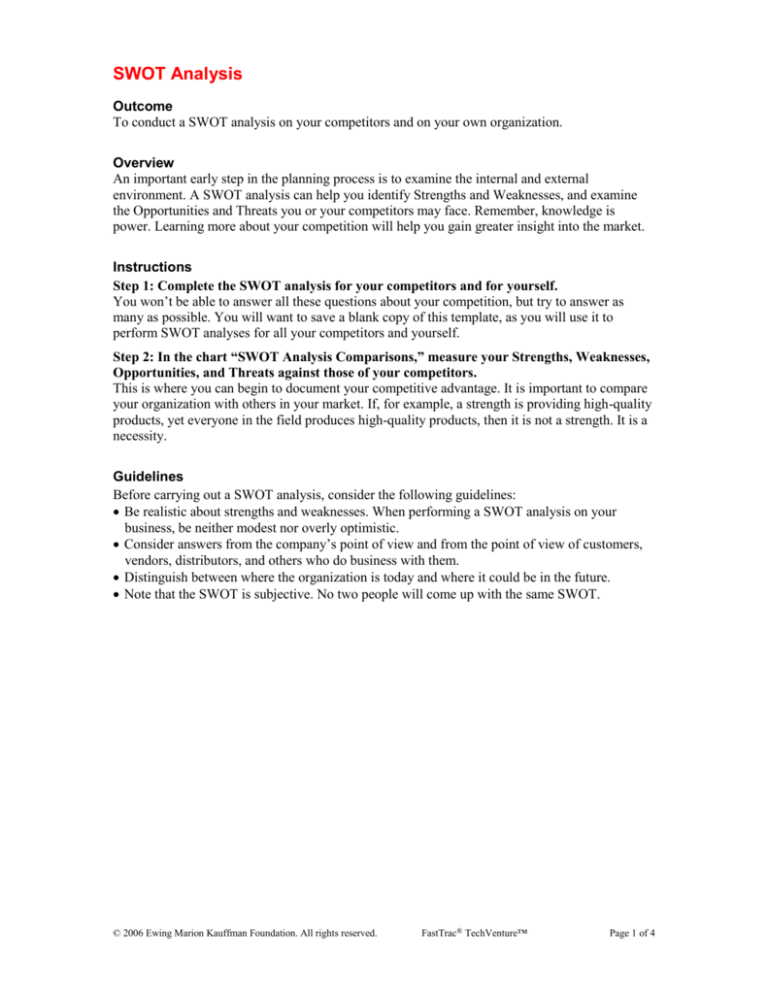
SWOT Analysis
Outcome
To conduct a SWOT analysis on your competitors and on your own organization.
Overview
An important early step in the planning process is to examine the internal and external
environment. A SWOT analysis can help you identify Strengths and Weaknesses, and examine
the Opportunities and Threats you or your competitors may face. Remember, knowledge is
power. Learning more about your competition will help you gain greater insight into the market.
Instructions
Step 1: Complete the SWOT analysis for your competitors and for yourself.
You won’t be able to answer all these questions about your competition, but try to answer as
many as possible. You will want to save a blank copy of this template, as you will use it to
perform SWOT analyses for all your competitors and yourself.
Step 2: In the chart “SWOT Analysis Comparisons,” measure your Strengths, Weaknesses,
Opportunities, and Threats against those of your competitors.
This is where you can begin to document your competitive advantage. It is important to compare
your organization with others in your market. If, for example, a strength is providing high-quality
products, yet everyone in the field produces high-quality products, then it is not a strength. It is a
necessity.
Guidelines
Before carrying out a SWOT analysis, consider the following guidelines:
Be realistic about strengths and weaknesses. When performing a SWOT analysis on your
business, be neither modest nor overly optimistic.
Consider answers from the company’s point of view and from the point of view of customers,
vendors, distributors, and others who do business with them.
Distinguish between where the organization is today and where it could be in the future.
Note that the SWOT is subjective. No two people will come up with the same SWOT.
© 2006 Ewing Marion Kauffman Foundation. All rights reserved.
FastTrac® TechVenture™
Page 1 of 4
SWOT Analysis (Strengths and Weaknesses)
Strengths
Weaknesses
Advantages?
Disadvantages?
Capabilities?
Product – price, value,
quality, innovation?
Resources – assets,
people, expertise?
Financials? Financial
reserves, likely returns?
Cash flow, start-up
cash-drain?
Marketing – reach,
distribution, awareness?
Distribution channels –
continuity, supply chain
robustness?
Timescales, deadlines,
and pressures?
Location and
geographical?
Processes, systems, IT,
communications?
Morale, commitment,
leadership? Cultural,
attitudinal, behavioral?
Management cover,
succession?
© 2006 Ewing Marion Kauffman Foundation. All rights reserved.
FastTrac® TechVenture™
Page 2 of 4
SWOT Analysis (Opportunities and Threats)
Opportunities
Threats
Competitors’
vulnerabilities?
Political or legislative
effects?
Industry trends?
Environmental effects?
Seasonality, weather
effects?
Technology
development and
innovation?
New markets, vertical,
horizontal?
Changes in
sociocultural
environment?
Partnerships, agencies,
distribution?
Economy – home,
abroad?
© 2006 Ewing Marion Kauffman Foundation. All rights reserved.
FastTrac® TechVenture™
Page 3 of 4
SWOT Analysis Comparisons
Your Company
Competitor A
Competitor B
Strengths
Strengths
Strengths
Weaknesses
Weaknesses
Weaknesses
Opportunities
Opportunities
Opportunities
Threats
Threats
Threats
© 2006 Ewing Marion Kauffman Foundation. All rights reserved.
FastTrac® TechVenture™
Page 4 of 4





